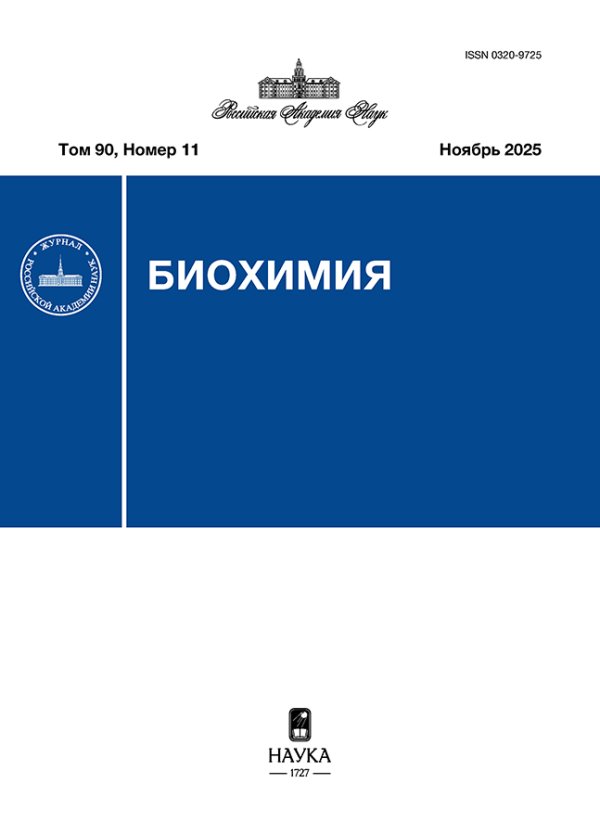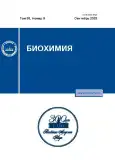Получение и характеристика фоторина, нового белкового ингибитора протеаз из энтомопатогенной бактерии photorhabdus laumondii
- Авторы: Бердышев И.М1, Светлова А.О1, Чухонцева К.Н1, Карасева М.А1, Варижук А.М2, Филатов В.В3, Клеймёнов С.Ю4,5, Костров С.В1, Демидюк И.В1
-
Учреждения:
- Национальный исследовательский центр «Курчатовский институт»
- Московский физико-технический институт
- Институт проблем химической физики РАН
- ФИЦ Биотехнологии РАН, Институт биохимии имени А.Н. Баха
- Институт биологии развития имени Н.К. Кольцова РАН
- Выпуск: Том 88, № 9 (2023)
- Страницы: 1642-1654
- Раздел: Статьи
- URL: https://journals.rcsi.science/0320-9725/article/view/141494
- DOI: https://doi.org/10.31857/S0320972523090154
- EDN: https://elibrary.ru/WVEBDF
- ID: 141494
Цитировать
Полный текст
Аннотация
Ключевые слова
Об авторах
И. М Бердышев
Национальный исследовательский центр «Курчатовский институт»123182 Москва, Россия
А. О Светлова
Национальный исследовательский центр «Курчатовский институт»123182 Москва, Россия
К. Н Чухонцева
Национальный исследовательский центр «Курчатовский институт»123182 Москва, Россия
М. А Карасева
Национальный исследовательский центр «Курчатовский институт»123182 Москва, Россия
А. М Варижук
Московский физико-технический институт141701 Долгопрудный, Московская обл., Россия
В. В Филатов
Институт проблем химической физики РАН142432 Черноголовка, Московская обл., Россия
С. Ю Клеймёнов
ФИЦ Биотехнологии РАН, Институт биохимии имени А.Н. Баха;Институт биологии развития имени Н.К. Кольцова РАН119071 Москва, Россия;119334 Москва, Россия
С. В Костров
Национальный исследовательский центр «Курчатовский институт»123182 Москва, Россия
И. В Демидюк
Национальный исследовательский центр «Курчатовский институт»
Email: ilyaduk@yandex.ru
123182 Москва, Россия
Список литературы
- Cabral-Pacheco, G. A., Garza-Veloz, I., Castruita-De la Rosa, C., Ramirez-Acuna, J. M., Perez-Romero, B. A., Guerrero-Rodriguez, J. F., Martinez-Avila, N., and Martinez-Fierro, M. L. (2020) The roles of matrix metalloproteinases and their inhibitors in human diseases, Int. J. Mol. Sci., 21, 9739, doi: 10.3390/ijms21249739.
- D'Acunto, E., Fra, A., Visentin, C., Manno, M., Ricagno, S., Galliciotti, G., and Miranda, E. (2021) Neuroserpin: structure, function, physiology and pathology, Cell. Mol. Life Sci., 78, 6409-6430, doi: 10.1007/s00018-021-03907-6.
- Kelly-Robinson, G. A., Reihill, J. A., Lundy, F. T., McGarvey, L. P., Lockhart, J. C., Litherland, G. J., Thornbury, K. D., and Martin, S. L. (2021) The serpin superfamily and their role in the regulation and dysfunction of serine protease activity in COPD and other chronic lung diseases, Int. J. Mol. Sci., 22, 6351, doi: 10.3390/ijms22126351.
- Sillen, M., and Declerck, P. J. (2021) A narrative review on plasminogen activator inhibitor-1 and its (patho)physiological role: to target or not to target? Int. J. Mol. Sci., 22, 2721, doi: 10.3390/ijms22052721.
- Wilkinson, D. J. (2021) Serpins in cartilage and osteoarthritis: what do we know? Biochem. Soc. Trans., 49, 1013-1026, doi: 10.1042/BST20201231.
- Rawlings, N. D., Barrett, A. J., Thomas, P. D., Huang, X., Bateman, A., and Finn, R. D. (2018) The MEROPS database of proteolytic enzymes, their substrates and inhibitors in 2017 and a comparison with peptidases in the PANTHER database, Nucleic Acids Res., 46, D624-D632, doi: 10.1093/nar/gkx1134.
- Chukhontseva, K. N., Berdyshev, I. M., Safina, D. R., Karaseva, M. A., Bozin, T. N., Salnikov, V. V., Konarev, P. V., Volkov, V. V., Grishin, A. V., Kozlovskiy, V. I., Kostrov, S. V., and Demidyuk, I. V. (2021) The protealysin operon encodes emfourin, a prototype of a novel family of protein metalloprotease inhibitors, Int. J. Biol. Macromol., 169, 583-596, doi: 10.1016/j.ijbiomac.2020.12.170.
- Demidyuk, I. V., Gromova, T. Y., and Kostrov, S. V. (2013) Protealysin. in Handbook of Proteolytic Enzymes (Rawlings, N. D., and Salvesen, G., eds.), 3 Ed., Academic Press, Oxford, pp. 507-602.
- Demidyuk, I. V., Kalashnikov, A. E., Gromova, T. Y., Gasanov, E. V., Safina, D. R., Zabolotskaya, M. V., Rudenskaya, G. N., and Kostrov, S. V. (2006) Cloning, sequencing, expression, and characterization of protealysin, a novel neutral proteinase from Serratia proteamaculans representing a new group of thermolysin-like proteases with short N-terminal region of precursor, Protein Express. Purif., 47, 551-561, doi: 10.1016/j.pep.2005.12.005.
- Bozhokina, E. S., Tsaplina, O. A., Efremova, T. N., Kever, L. V., Demidyuk, I. V., Kostrov, S. V., Adam, T., Komissarchik, Y. Y., and Khaitlina, S. Y. (2011) Bacterial invasion of eukaryotic cells can be mediated by actin-hydrolysing metalloproteases grimelysin and protealysin, Cell Biol. Int., 35, 111-118, doi: 10.1042/CBI20100314.
- Tsaplina, O. A., Demidyuk, I., Artamonova, T., Khodorkovsky, M., and Khaitlina, S. (2020) Cleavage of the outer membrane protein OmpX by protealysin regulates Serratia proteamaculans invasion, FEBS Lett., 594, 3095-3107, doi: 10.1002/1873-3468.13897.
- Tsaplina, O. A., Efremova, T., Demidyuk, I., and Khaitlina, S. (2012) Filamentous actin is a substrate for protealysin, a metalloprotease of invasive Serratia proteamaculans, FEBS J., 279, 264-274, doi: 10.1111/j.1742-4658.2011.08420.x.
- Цаплина О. А., Ефремова Т. Н., Кевер Л. В., Комиссарчик Я. Ю., Демидюк И. В., Костров С. В., Хайтлина С. Ю. (2009) Выявление актиназной активности протеализина, Биохимия, 74, 797-804.
- Khaitlina, S., Bozhokina, E., Tsaplina, O., and Efremova, T. (2020) Bacterial actin-specific endoproteases grimelysin and protealysin as virulence factors contributing to the invasive activities of Serratia, Int. J. Mol. Sci., 21, 4025, doi: 10.3390/ijms21114025.
- Cabral, C. M., Cherqui, A., Pereira, A., and Simoes, N. (2004) Purification and characterization of two distinct metalloproteases secreted by the entomopathogenic bacterium Photorhabdus sp. Strain Az29, Appl. Environ. Microbiol., 70, 3831-3838, doi: 10.1128/aem.70.7.3831-3838.2004.
- Held, K. G., LaRock, C. N., D'Argenio, D. A., Berg, C. A., and Collins, C. M. (2007) A metalloprotease secreted by the insect pathogen Photorhabdus luminescens induces melanization, Appl. Environ. Microbiol., 73, 7622-7628, doi: 10.1128/aem.01000-07.
- Eshwar, A. K., Wolfrum, N., Stephan, R., Fanning, S., and Lehner, A. (2018) Interaction of matrix metalloproteinase-9 and Zpx in Cronobacter turicensis LMG 23827(T) mediated infections in the zebrafish model, Cell. Microbiol., 20, e12888, doi: 10.1111/cmi.12888.
- Feng, T., Nyffenegger, C., Hojrup, P., Vidal-Melgosa, S., Yan, K. P., Fangel, J. U., Meyer, A. S., Kirpekar, F., Willats, W. G., and Mikkelsen, J. D. (2014) Characterization of an extensin-modifying metalloprotease: N-terminal processing and substrate cleavage pattern of Pectobacterium carotovorum Prt1, Appl. Microbiol. Biotechnol., 98, 10077-10089, doi: 10.1007/s00253-014-5877-2.
- Kyöstiö, S. R., Cramer, C. L., and Lacy, G. H. (1991) Erwinia carotovora subsp. carotovora extracellular protease: characterization and nucleotide sequence of the gene, J. Bacteriol., 173, 6537-6546, doi: 10.1128/jb.173.20.6537-6546.1991.
- Tsaplina, O., Khaitlina, S., Chukhontseva, K., Karaseva, M., Demidyuk, I., Bakhlanova, I., Baitin, D., Artamonova, T., Vedyaykin, A., Khodorkovskii, M., and Vishnyakov, I. (2022) Protealysin targets the bacterial housekeeping proteins FtsZ and RecA, Int. J. Mol. Sci., 23, 10787, doi: 10.3390/ijms231810787.
- Clarke, D. J. (2008) Photorhabdus: a model for the analysis of pathogenicity and mutualism, Cell. Microbiol., 10, 2159-2167, doi: 10.1111/j.1462-5822.2008.01209.x.
- Ciche, T. A., Kim, K. S., Kaufmann-Daszczuk, B., Nguyen, K. C., and Hall, D. H. (2008) Cell invasion and matricide during Photorhabdus luminescens transmission by heterorhabditis bacteriophora nematodes, Appl. Environ. Microbiol., 74, 2275-2287, doi: 10.1128/AEM.02646-07.
- Cimen, H., Touray, M., Gulsen, S. H., Erincik, O., Wenski, S. L., Bode, H. B., Shapiro-Ilan, D., and Hazir, S. (2021) Antifungal activity of different Xenorhabdus and Photorhabdus species against various fungal phytopathogens and identification of the antifungal compounds from X. szentirmaii, Appl. Microbiol. Biotechnol., 105, 5517-5528, doi: 10.1007/s00253-021-11435-3.
- Muangpat, P., Suwannaroj, M., Yimthin, T., Fukruksa, C., Sitthisak, S., Chantratita, N., Vitta, A., and Thanwisai, A. (2020) Antibacterial activity of Xenorhabdus and Photorhabdus isolated from entomopathogenic nematodes against antibiotic-resistant bacteria, PLoS One, 15, e0234129, doi: 10.1371/journal.pone.0234129.
- Bowen, D., Blackburn, M., Rocheleau, T., Grutzmacher, C., and ffrench-Constant, R. H. (2000) Secreted proteases from Photorhabdus luminescens: separation of the extracellular proteases from the insecticidal Tc toxin complexes, Insect Biochem. Mol. Biol., 30, 69-74, doi: 10.1016/s0965-1748(99)00098-3.
- Marokházi, J., Kóczán, G., Hudecz, F., Gráf, L., Fodor, A., and Venekei, I. (2004) Enzymic characterization with progress curve analysis of a collagen peptidase from an enthomopathogenic bacterium, Photorhabdus luminescens, Biochem. J., 379, 633-640, doi: 10.1042/bj20031116.
- Bradford, M. M. (1976) A rapid and sensitive method for the quantitation of microgram quantities of protein utilizing the principle of protein-dye binding, Anal. Biochem., 72, 248-254, doi: 10.1006/abio.1976.9999.
- Гаспаров В. С., Дегтярь В. Г. (1994) Определение белка по связыванию с красителем кумасси бриллиантовым голубым G-250, Биохимия, 59, 763-777.
- Laemmli, U. K. (1970) Cleavage of structural proteins during the assembly of the head of bacteriophage T4, Nature, 227, 680-685, doi: 10.1038/227680a0.
- Maniatis, T., Fritsch, E. F., Sambrook, J., and Engel, J. (1985) Molecular cloning - A laboratory manual, in Acta Biotechnologica, New York, Cold Spring Harbor Laboratory, 5, 104-104, doi: 10.1016/0307-4412(83)90068-7.
- Lennox, E. S. (1955) Transduction of linked genetic characters of the host by bacteriophage P1, Virology, 1, 190-206, doi: 10.1016/0042-6822(55)90016-7.
- Kozlovski, V., Brusov, V., Sulimenkov, I., Pikhtelev, A., and Dodonov, A. (2004) Novel experimental arrangement developed for direct fullerene analysis by electrospray time-of-flight mass spectrometry, Rapid Commun. Mass Spectrom., 18, 780-786, doi: 10.1002/rcm.1405.
- Sreerama, N., and Woody, R. W. (2000) Estimation of protein secondary structure from circular dichroism spectra: comparison of CONTIN, SELCON, and CDSSTR methods with an expanded reference set, Anal. Biochem., 287, 252-260, doi: 10.1006/abio.2000.4880.
- Drew, E. D., and Janes, R. W. (2020) PDBMD2CD: providing predicted protein circular dichroism spectra from multiple molecular dynamics-generated protein structures, Nucleic Acids Res., 48, W17-W24, doi: 10.1093/nar/gkaa296.
- Chukhontseva, K. N., Salnikov, V. V., Morenkov, O. S., Kostrov, S. V., and Demidyuk, I. V. (2019) Protealysin is not secreted constitutively, Protein Peptide Lett., 26, 221-226, doi: 10.2174/0929866526666181212114907.
- Schagger, H. (2006) Tricine-SDS-PAGE, Nat. Protoc., 1, 16-22, doi: 10.1038/nprot.2006.4.
- Karaseva, M. A., Chukhontseva, K. N., Lemeskina, I. S., Pridatchenko, M. L., Kostrov, S. V., and Demidyuk, I. V. (2019) An internally quenched fluorescent peptide substrate for protealysin, Sci. Rep., 9, 14352, doi: 10.1038/s41598-019-50764-2.
- Berdyshev, I. M., Karaseva, M. A., and Demidyuk, I. V. (2022) Assay for protealysin-like protease inhibitor activity, Bio Protoc., 12, e4528, doi: 10.21769/BioProtoc.4528.
- Goliĉnik, M., and Stojan, J. (2004) Slow-binding inhibition: A theoretical and practical course for students, Biochem. Mol. Biol. Educat., 32, 228-235, doi: 10.1002/bmb.2004.494032040358.
- Butterworth, P. J. (1972) The use of Dixon plots to study enzyme inhibition, Biochim. Biophys Acta, 289, 251-253, doi: 10.1016/0005-2744(72)90074-5.
- Dixon, M. (1953) The determination of enzyme inhibitor constants, Biochem. J., 55, 170-171, doi: 10.1042/bj0550170.
- Bozin, T. N., Berdyshev, I. M., Chukhontseva, K. N., Karaseva, M. A., Konarev, P. V., Varizhuk, A. M., Lesovoy, D. M., Arseniev, A. S., Kostrov, S. V., Bocharov, E. V., and Demidyuk, I. V. (2023) NMR structure of emfourin, a novel protein metalloprotease inhibitor: insights into the mechanism of action, J. Biol. Chem., 299, 104585, doi: 10.1016/j.jbc.2023.104585.
- Bozin, T. N., Chukhontseva, K. N., Lesovoy, D. M., Filatov, V. V., Kozlovskiy, V. I., Demidyuk, I. V., and Bocharov, E. V. (2021) NMR assignments and secondary structure distribution of emfourin, a novel proteinaceous protease inhibitor, Biomol. NMR Assign., 15, 361-366, doi: 10.1007/s12104-021-10030-x.
- Chiu, M. H., and Prenner, E. J. (2011) Differential scanning calorimetry: An invaluable tool for a detailed thermodynamic characterization of macromolecules and their interactions, J. Pharm. Bioallied Sci., 3, 39-59, doi: 10.4103/0975-7406.76463.
- Gianni, S., Dogan, J., and Jemth, P. (2014) Distinguishing induced fit from conformational selection, Biophys. Chem., 189, 33-39, doi: 10.1016/j.bpc.2014.03.003.
- Hammes, G. G., Chang, Y. C., and Oas, T. G. (2009) Conformational selection or induced fit: a flux description of reaction mechanism, Proc. Natl. Acad. Sci. USA, 106, 13737-13741, doi: 10.1073/pnas.0907195106.
- Masson, P., and Lushchekina, S. V. (2016) Slow-binding inhibition of cholinesterases, pharmacological and toxicological relevance, Arch. Biochem. Biophys., 593, 60-68, doi: 10.1016/j.abb.2016.02.010.
- Demidyuk, I. V., Gromova, T. Y., Polyakov, K. M., Melik-Adamyan, W. R., Kuranova, I. P., and Kostrov, S. V. (2010) Crystal structure of the protealysin precursor: insights into propeptide function, J. Biol. Chem., 285, 2003-2013, doi: 10.1074/jbc.M109.015396.
- Marokházi, J., Lengyel, K., Pekár, S., Felföldi, G., Patthy, A., Gráf, L., Fodor, A., and Venekei, I. (2004) Comparison of proteolytic activities produced by entomopathogenic Photorhabdus bacteria: strain- and phase-dependent heterogeneity in composition and activity of four enzymes, Appl. Environ. Microbiol., 70, 7311-7320, doi: 10.1128/aem.70.12.7311-7320.2004.
- Demidyuk, I. V., Gasanov, E. V., Safina, D. R., and Kostrov, S. V. (2008) Structural organization of precursors of thermolysin-like proteinases, Protein J., 27, 343-354, doi: 10.1007/s10930-008-9143-2.
Дополнительные файлы










